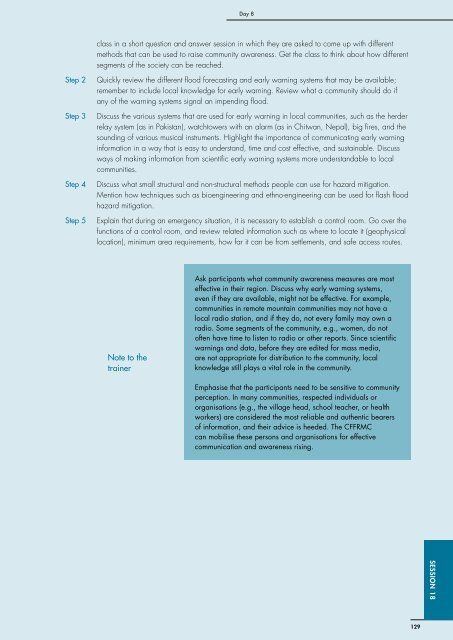Flash Flood Risk Management â A Training of Trainers ... - ReliefWeb
Flash Flood Risk Management â A Training of Trainers ... - ReliefWeb
Flash Flood Risk Management â A Training of Trainers ... - ReliefWeb
Create successful ePaper yourself
Turn your PDF publications into a flip-book with our unique Google optimized e-Paper software.
Day 8<br />
class in a short question and answer session in which they are asked to come up with different<br />
methods that can be used to raise community awareness. Get the class to think about how different<br />
segments <strong>of</strong> the society can be reached.<br />
Step 2<br />
Step 3<br />
Step 4<br />
Step 5<br />
Quickly review the different flood forecasting and early warning systems that may be available;<br />
remember to include local knowledge for early warning. Review what a community should do if<br />
any <strong>of</strong> the warning systems signal an impending flood.<br />
Discuss the various systems that are used for early warning in local communities, such as the herder<br />
relay system (as in Pakistan), watchtowers with an alarm (as in Chitwan, Nepal), big fires, and the<br />
sounding <strong>of</strong> various musical instruments. Highlight the importance <strong>of</strong> communicating early warning<br />
information in a way that is easy to understand, time and cost effective, and sustainable. Discuss<br />
ways <strong>of</strong> making information from scientific early warning systems more understandable to local<br />
communities.<br />
Discuss what small structural and non-structural methods people can use for hazard mitigation.<br />
Mention how techniques such as bioengineering and ethno-engineering can be used for flash flood<br />
hazard mitigation.<br />
Explain that during an emergency situation, it is necessary to establish a control room. Go over the<br />
functions <strong>of</strong> a control room, and review related information such as where to locate it (geophysical<br />
location), minimum area requirements, how far it can be from settlements, and safe access routes.<br />
Note to the<br />
trainer<br />
Ask participants what community awareness measures are most<br />
effective in their region. Discuss why early warning systems,<br />
even if they are available, might not be effective. For example,<br />
communities in remote mountain communities may not have a<br />
local radio station, and if they do, not every family may own a<br />
radio. Some segments <strong>of</strong> the community, e.g., women, do not<br />
<strong>of</strong>ten have time to listen to radio or other reports. Since scientific<br />
warnings and data, before they are edited for mass media,<br />
are not appropriate for distribution to the community, local<br />
knowledge still plays a vital role in the community.<br />
Emphasise that the participants need to be sensitive to community<br />
perception. In many communities, respected individuals or<br />
organisations (e.g., the village head, school teacher, or health<br />
workers) are considered the most reliable and authentic bearers<br />
<strong>of</strong> information, and their advice is heeded. The CFFRMC<br />
can mobilise these persons and organisations for effective<br />
communication and awareness rising.<br />
session 18<br />
129

















